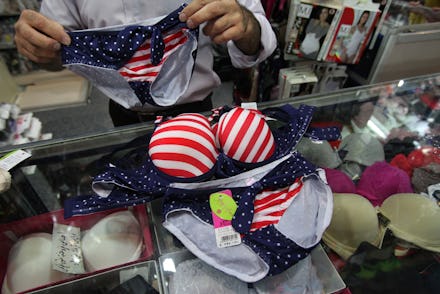The American Flag Is Now a Fashion Trend in the Country You'd Least Expect

During last June's presidential elections in Iran, a man stood in line to vote proudly wearing a T-shirt with an enormous flag covering his chest.
But it wasn't just any flag: It was America's. The photo was a hit online.
It wasn't an isolated incident. Visiting Tajrish, a bazaar and shopping mall in North Tehran last August, I bought a pair of leggings that had Old Glory thrown up all over them. The saleswoman told me that they particularly popular during the very month Iran's new president, Hassan Rouhani, was inaugurated.
Perhaps this is a symbol of the disconnect between how Iranians actually view America, and how Americans view Iran.
According to a poll taken by the 2009 World Public Opinion, 63% of Iranians hold favorable attitudes towards the U.S. For many Americans, Iran seems like an unlikely place where clothing emblazoned with stars and stripes would be trendy.
The stereotypical picture Americans paint of Iran involves mad mullahs, women in chadors and nuclear bombs. According to a Pew Research study, 69% of Americans have a negative view of Iran – and that might be rooted in their limited knowledge of what Iranians are actually like.
It was almost as if this fashion trend amongst Iranians was setting the mood for the historic phone call in September between President Barack Obama and his Iranian counterpart Hassan Rouhani, a call that marked the first contact the nations would make since the 1979 Revolution.
The trendy American flag is perhaps telling of the mood on the ground: the average Iranian no longer had any animosity toward the United States of America.
But this wasn't always the case. My cousin was arrested in 1998 for wearing an American flag T-shirt. As films like Argo and other stereotypical scenes of Iran tend to display, the American flag was never meant to be worn. Rather, it was meant to be burned. That was exactly my thought when my 13-year-old self moved to the Islamic Republic of Iran in 1999. Upon declaring my American identity, I anticipated seeing fire burn in Iranians' eyes.
But instead, I got smiles.
We would proceed to talk about American pop culture, depending on what was cool at the time: Britney Spears, Eminem, Leonardo DiCaprio, Spider-Man, MTV, Harry Potter — the list was unending. Iranians were and continue to be up-to-date on all the latest films and music thanks to the Internet. Bootleg franchises of American fast food continue to pop up in various cities. Despite this, it is important to know that the public's display of animosity people tend to associate with Iran — that not only consisted of flag burning but chants of Marg Bar Amreeka or "death to America" — had mostly to do with a profound instigator: history.
In 1979, Iranians were fed up with the United States meddling in its domestic affairs. There was a long list of things Iranians wanted the United States held accountable for: a CIA-backed coup against the country's democratically elected Prime Minister Mohammad Mossadegh in 1953, support of the Shah's dictatorship, and the U.S.' inaction surrounding countless human rights violations the CIA-trained secret police SAVAK committed.
Despite the severing of relations after the hostage crisis that lasted 444 days, the U.S. supported Iraq's tyrant Saddam Hussein during the war between Iran and Iraq in the 1980s, and shot down an Iran Air passenger plane killing 290 on board, an incident for which the U.S. has not apologized. These examples are among the reasons why we still see once a year, several thousand Iranians throughout the country burn the American flag.
Still – Iran might be the place where you'll find the most pro-Western, pro-American stance in the region. And maybe it is time for America (and its government) to understand that.
In my case, while visiting the historical city of Esfahan, Iranians asked me if I was from Texas. Not quite, I responded. I'm from California. An even bigger smile, "Los Angeles?!?" The City of Angels is well-known amongst Iranians, it has the largest population of Iranian diaspora.
Waiting at a stoplight on Valiasr Avenue in Tehran, two street vendors walked the lanes looking for a potential buyer. One was selling a Scream mask, the other wore an American flag and was selling Mickey Mouse ears with blinking lights.
Journalist Nicholas Kristof said it best in 2004: "Finally, I've found a pro-American country."